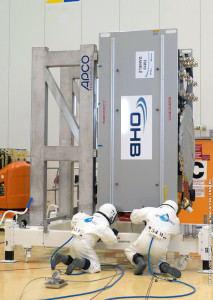
Technicians donned spacesuit-like protective outfits to handle the toxic hydrazine fuel that will enable the two satellites to fine-tune their orbits and orientation over the course of their working lives of 12 years or more.
The 13th Galileo satellite was fuelled on 3 May, with the 14th being fuelled a day later.
After fuelling both satellites have been connected to “checkout terminal equipment” to enable battery charging and atomic clock monitoring.
They are now ready for the next step in the launch preparations: attachment to the dispenser that will hold them during the ascent to orbit before release. The assembly will next be attached to the Fregat upper stage.
Placed atop the other three Soyuz stages, the reignitable Fregat (as much a spacecraft as a rocket stage) will carry the satellites the bulk of the way to their target 23 500 km altitude during a flight of almost four hours.
Steps so far
This latest Galileo campaign began when the cargo Boeing 747 carrying the pair touched down at French Guiana’s Cayenne – Félix Eboué Airport on 5 April. They were driven by lorry straight to the satellite preparation facility in the space centre, where they were unboxed from their protective containers that same day.
Next, after they were checked to ensure they had sustained no damage during their travels, came their “fit check”, when they were mechanically and electrically linked to the dispenser.
The final loading of their onboard software was also performed, including an update of the latest and final parameters, followed by testing to confirm the good health of the satellites. They were then switched off, which is their configuration for launch.
As part of the process, Flight Model no. 10 in the series of Full Operational Capability (FOC) Galileo platforms has been “topped off” in the Spaceport’s S3B payload preparation facility.
This satellite is named for Lithuanian student Danielė, continuing the practice of designating Galileo spacecraft after youngsters who created space and aeronautics-related drawings that were selected by national juries in European Union member states.
This month’s dual Galileo payload mission is designated Flight VS15 in Arianespace’s launcher family numbering system. It will be the 15th liftoff of the workhorse launcher from French Guiana since Soyuz’ introduction at the Spaceport in 2011.
